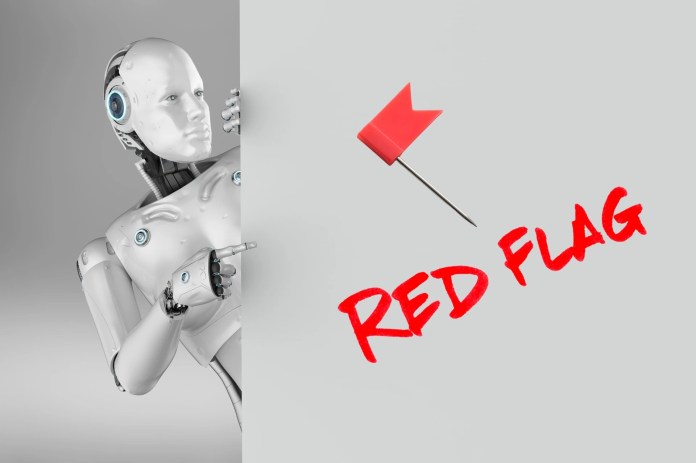Spotting AI writing is a lot like spotting a fake Gucci bag or a knockoff pair of Nikes. Just like when it comes to the bag or shoe, it looks polished at the first glance, but when you hold up light into it, you figure out something isn’t right. AI generated content often have certain giveaways. I’ll be listing my findings in this article. If you want your content to stand out as authentic, you’ll have to recognize these tells and learn how to fix them.
Let’s break down the most common AI red flags in writing and how you can turn them into strengths.
1. The Em Dash Obsession
Starting with the obvious, the em dash. Who doesn’t know that AI LOVES using the Em dash? It uses it for pauses, emphasis, and connections, sometimes all in the same paragraph. It uses it excessively.
Example:
“Content is changing—fast—and creators must adapt—or risk falling behind.”
Why It’s an AI Red Flag
We humans have never used the em dash so excessively, we use it sparingly. So when every paragraph has one, the text feels machine-like and not something a human would write.
Fix: You can keep the em dashes for dramatic pauses. Otherwise, just use commas, colons, or shorter sentences.
2. Predictable Parallelism
Next finding is a not so obvious one, when you use AI models frequently, that’s when you can spot this one. AI models often defaults to neat and parallel structures. But why? Because they feel “balanced”. I think this can be understood better with an example:
“It’s not just about learning, it’s about evolving.”
So, think of parallelism this way- “It’s not just about X, it’s about Y”
Why It’s an AI Red Flag
Honestly, parallelism is fine until it is used occasionally, but when used more the same phrases start sounding formulaic.
Fix: You have to shake it up. Instead try a short, punchy line after a longer one. Similarly, try different tones and expressions.
3. Buzzwords & Clichés
Unveiled. Transformative. Robust. Empower. You might have come across these empty jargons AI uses so frequently. I think AI uses these words hoping they’ll act like seasonings, and add flavor, but instead they just dilute the meaning. For example:
“This transformative solution empowers users with robust, innovative strategies.”
Why It’s an AI Red Flag
We’ve all heard these terms way often. They are more like fillers, which don’t add any real value. Most of the readers skim right past them.
Fix: Instead of using these fillers, make sure your content has the specifics. The words that actually add value. For example instead of writing “robust strategies,” you can say “a checklist that cuts editing time in half.”
4. Too-Polished Formality
AI texts are so flawless, that you’d never find a grammatical error or a spelling mistake. While being grammatically correct can be a great thing, it’s also lifeless. To give you an example:
“One must carefully consider the implications before proceeding with the endeavor.”
Why It’s an AI Red Flag
Human voice has quirks, excitement, storylines. From our writing our personality is shown. We’re more creative, less formal.
Fix: You need to inject personality and embrace minor imperfections in order to relate with everyone else.
5. Lack of Personal Voice or Anecdote
AI doesn’t have personal experiences to share, or personal jokes, anecdotes and that’s exactly what it misses. Let’s see the following example:
“Resilience is important when facing challenges.”
Why It’s an AI Red Flag
Readers crave authenticity. They enjoy a text more if it’s personal and it’s something that they can relate to. A lifeless statement feels too generic, like it could appear on a thousand blogs.
Fix: To make your content more relatable and likeable, you need to add your touch, your experience and your story to it.
6. Cookie-Cutter Intros and Conclusions
AI models use stock phrases like “Have you ever wondered…?” or “The Bigger Picture” or “Final Thoughts”. Let’s look at an example:
“Have you ever wondered how to improve your writing? In conclusion, practice makes perfect.”
Why It’s an AI Red Flag
Readers tend to switch up the content if they find that it starts or ends like every other blog post.
Fix: Get creative open with fun facts, stats, or story and make sure you close with energy.
7. Made-Up Facts
AI invents or hallucinates data, links that don’t even exist! Check out this blog post that reveals True stories of hallucinations by ChatGPT. An example of AI model inventing a fact:
“A 2024 Harvard study showed that 90% of readers prefer AI content.”
The reality is that no such study even exists. To add to it, it also gives you links to show you that the fact is real, but when you click on it, the link doesn’t even open or the page doesn’t even exist.
Why It’s an AI Red Flag
Any reader is going to lose trust instantly when they find a made up fact or catch a fake.
Fix: Fact-check everything. If you can’t verify a stat, either cut it or replace it with lived experience.
Quick Reference Table
| Red Flag | Why It Rings AI-ish | Fix It With… |
|---|---|---|
| Em-dash overuse | Feels robotic or formulaic | Limit use; favor commas or parentheses |
| Parallel sentences | Predictable and flat | Vary structure and tone |
| Buzzwords & clichés | Shallow and vague | Use specific, concrete language |
| Too-polished tone | Lacks human texture | Add voice imperfections, tone shifts |
| No personal voice | Feels detached | Insert anecdotes or opinions |
| Formulaic openings/closings | Cliché and dull | Start/end with punchy, unique hooks |
| Fake or unsupported facts | Misleading and untrustworthy | Verify or rephrase with truth |
Wrapping It Up
AI models are incredible assistants. And there’s nothing wrong in using them. They help us work smarter and faster. But they do leave behind some fingerprints. To make the best use of it and in order to stand out make sure you use the above check list to get rid of the AI red flags in writing. If you’re also looking to sharpen the human side of your craft, check out this piece on why soft skills for resume are actually power skills in the AI age.



